Seafood Preparation -
Tips for Identifying Fresh Fish & Seafood
When preparing your fish and seafood for
recipes, below are some useful tips and information that make life easier!
Tips on
Identifying Fresh Fish:
* Fresh fish have plump, bright eyes. If the eyes are
glazed or
dull and sunken, the fish is not fresh.
* If a fish is gutted, the blood along the backbone should be
brightly coloured, if it's not the fish is not fresh.
* A strong "fishy" odor is another indication that
the fish is not fresh.
The smell should be fresh and pleasant. Spoiled fish
has a strong,
unpleasant ammonia-like smell that you will quickly recognise.
* If you have frozen fish, once thawed you should use it
within 24 hours - 48 at the most. Do not refreeze fish.
|
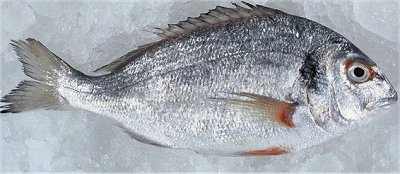 |
|
Picture of a fresh
whole fish. Notice the bright eyes- this is a
very good indication of the freshness of whole
fish. The longer the fish have been dead, the
more the eyes are glazed, opaque, dull or
sunken. |
How to tell if fish
fillets are fresh:
Fish fillets and steaks should have firm, elastic flesh and
a fresh-cut, moist appearance, with no browning around the
edges. Fillets separate if they are left too long in the
case. The flesh should be almost translucent – as if you can
almost see through it. There should be little evidence of
bruising or reddening of the flesh from retention of blood.
Prepackaged steaks and fillets should contain a minimum of
liquid. Fish fillets stored in liquid deteriorate quickly.
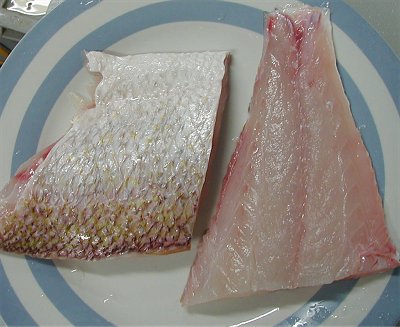 |
|
Fresh Red Snapper
Fillets |
Scallops are not usually sold
live because they are highly perishable. Typically scallops
are shucked at sea shortly after capture. On occasion, day
boats will bring whole scallops to market or local
restaurants. Fresh scallop meats have a firm texture and a
distinctly sweet odor. A sour or iodine smell indicates
spoilage. The smaller bay and calico scallops are usually
creamy white, although there may be some normal light tan or
pink coloration. The larger sea scallops are also generally
creamy white, although they may show some normal light
orange or pink color.
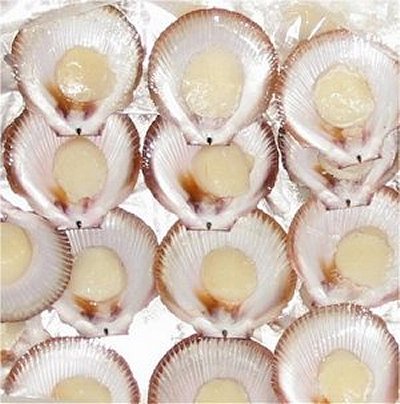 |
|
Fresh Scallops on
Shell |
Live crabs and lobsters should show leg movement, and
the tail of lobsters should curl tightly underneath the body
and not hang down when the lobster is picked up. Lobsters
and crabs will not be very active if they have been
refrigerated, but they should move at least a little bit.
Cooked lobsters,
crabs, slipper lobsters or bugs in the
shell should be bright red and have no disagreeable odor.
Picked lobster meat will be snowy white with red tints,
while crab meat is white with red or brown tints, depending
on the species or the section of the body it was picked
from.
|
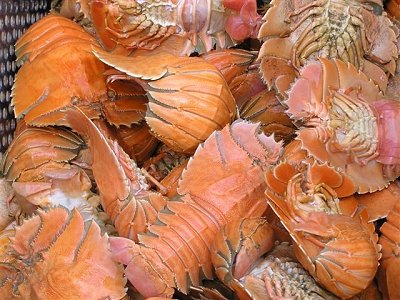 |
|
Fresh Cooked Moreton
Bay Bugs or Slipper Lobsters |
Cooked, picked lobster or crab meat
should have good color and no disagreeable odor.
|
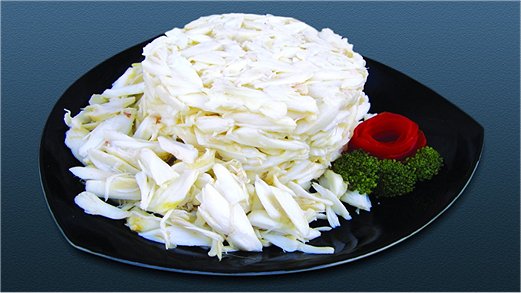 |
|
Fresh Cooked Crab
Meat |
Prawns | Shrimps | Raw shrimp meat
should be firm and have a mild odor.
The shells of most varieties are translucent with a grayish
green, pinkish tan, or light pink tint. The shells should
not have blackened edges or black spots – this is a sign of
quality loss. Cooked shrimp meat should be firm and have no
disagreeable odor. The color of the meat should be white
with red or pink tints. Tiger shrimp have bluish colored
shells with black lines between the segments of the shell
(these are not black spots). The photos below show fresh
green (raw) prawns or shrimp and freshly cooked prawns
shrimp.
|
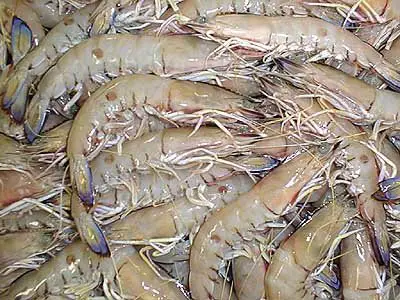 |
|
Fresh green (raw)
King Prawns - Very Fresh whole Shrimp |
|
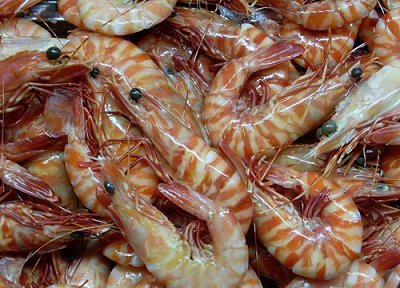 |
|
Fresh Cooked Tiger
Prawns | Freshly cooked Tiger Shrimp |
Whole squid should have eyes that are clear and full,
and the skin should be un-torn and the meat very firm. The
skin of fresh squid is cream colored with reddish brown
spots. As squid ages, the skin turns pinkish and the flesh
will yellow.
|
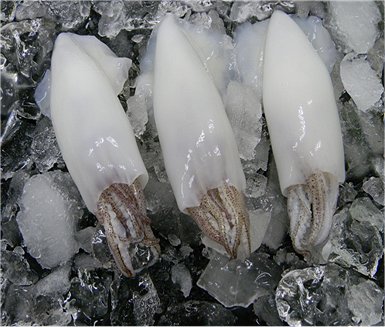 |
|
Fresh, cleaned Squid |
Seafood Recipes
Fish & Seafood Recipe Videos
- How to
cook & clean abalone, sea bass with pepper sauce,
Kentucky fried catfish, miso glazed barramundi, rock
oysters with caviar, linguini with white clam sauce,
Wild Alaska Tamarind Cod, Jamaican codfish cakes,
lobster, scallops, mahi recipes and more
More information:
Seafood Health Facts: Making Smart Choices - A joint
project of Oregon State University, Cornell University, the
Universities of Delaware, Rhode Island, Florida & California
and the Community Seafood Initiative.
|